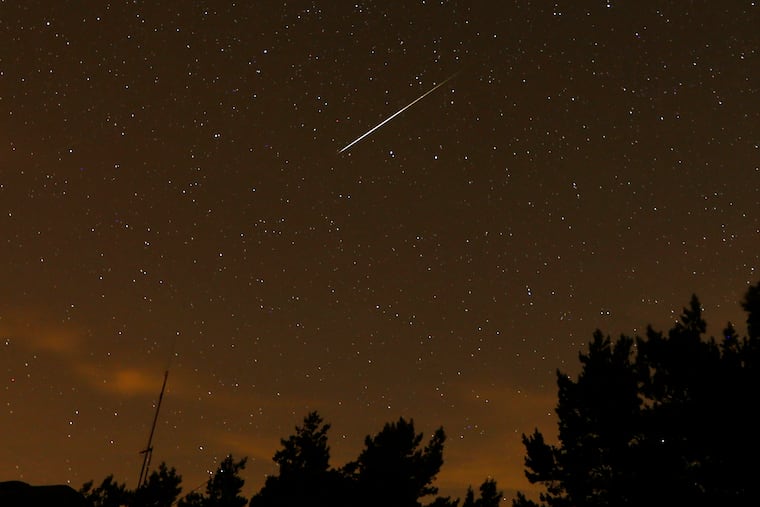The Geminids, the best meteor showers of the year, are about to star over Philly
Over time, the numbers of Geminid meteors have been increasing as earth has been passing through denser parts of the meteor stream.

A major difference between the most popular meteor showers of the year — the Perseids — and what discriminating sky-watchers hold are the year’s best — the Geminids — is a matter of degrees.
Actually, on average, about 35 to 40 degrees Fahrenheit.
The Geminids likely would eclipse the Perseids in popularity if they peaked in balmy mid-August when nighttime temperatures are in the 70s, rather than mid-December, when they are likely to be in the 30s. “They have passed the Perseids,” Bill Cooke, the lead of NASA’s Meteoroid Environments Office, said last week. That’s the result of cosmic developments in our solar system.
Veteran sky-watchers hold that the Geminids also appear to have an aesthetic edge. Named because they appear to radiate from the constellation Gemini, they tend to be bigger and denser than their counterparts and, thus, “produce bright meteors,” said Dwight Dulsky, with the Bucks-Mont Astronomical Association.
» READ MORE: A beginner’s guide to stargazing near Philadelphia
Added Cooke, “I‘ve seen some very pretty Geminid fireballs.” Those are larger meteors that explode as they sizzle through the atmosphere.
As many as 135 an hour can enter the atmosphere during the peak period, this year occurring late on the night of Wednesday into the early-morning hours of Thursday. And under a dark, country sky, about half of those may be visible, Cooke added.
What’s more, this year the peak coincides with the crescent, all-but-invisible moon, and the sky-viewing conditions should be ideal — clear, and without much water vapor. It won’t be like August, when the Perseids peak. It will be chilly, with temperatures forecast to fall into the mid- and upper 20s early Thursday, but the chances of any precipitation are zero.
What are the Geminids?
Other meteor showers, such as the Perseids, are the by-products of passing comets whose detritus sheds tiny particles into Earth’s atmosphere, where they travel up to 78,000 mph, burn up, and become incandescent. Meteors appear when the Earth passes through the debris.
The Geminids are different. They originate from an enigmatic body that NASA identifies as asteroid 3200 Phaethon. Its link to the Geminids wasn’t discovered until 1983.
And, unlike the Perseids, over the years meteors produced by the Geminids have been increasing. Cooke said the gravitational pull of Jupiter and other planets have altered the path of the debris stream.
“It’s not so much there’s more stuff,” he said. “We’re passing through a denser region of stuff.”
When is the best time to see the Geminids?
The peak of the showers will occur late Wednesday night into the early-morning hours of Thursday, although some might show up “a few hours” after sunset Wednesday, said Bucks-Mont’s Dulsky.
The peak hour would be 2 a.m. Thursday, said Cooke.
Radio-signal monitoring indicated that 10 to 15 Geminids entered the atmosphere per hour in the week before the peak in 2020, with as many as 140 per hour during the peak hours, according to the Severe Weather Europe site. That’s close to what NASA’s cameras have observed, said Cooke.
He said they typically start appearing five nights before the peak, with a big ramp-up on the night before. The drop-off occurs rather quickly after the peak, and by Saturday, they are pretty much gone until next year, Cooke said.
Sky-watchers advise taking at least 20 minutes to adjust to the darkness, and avoid looking at any lighted objects. “If you want ruin your night,” said Cooke, “look at your phone.”
Assuming you have to contend with light interference, look at the darkest part of the sky, which is directly overhead. Although the meteors appear to emanate from Gemini, they can appear anywhere in the sky.
Where is the best place to watch the Geminids?
This is one time when you won’t want to curse the darkness. You’ll want to get as far away from urban lighting as possible, and it isn’t getting any easier.
In a typical suburb, said Cooke, you may see one every three or four minutes, and Center City may be fine for nightlife, but not for meteor-watching.
One option would be to make the five-hour drive to Cherry Springs State Park, in far-north central Pennsylvania, to watch the show in one of the East’s premier dark spots.
» READ MORE: Pennsylvania has a dark oasis in the light-polluted East
It isn’t Cherry Springs, but you could do far worse than French Creek State Park, on the border of Chester and Berks Counties. Park at the Hopewell Lake lot, and chances are excellent you’ll encounter enthusiasts of the night sky. To contact the park, call 610-582-9680.
In South Jersey, a meteor-watching event begins at 9:30 p.m. Wednesday at Wharton State Forest. For information, contact 609-561-0024.
At the risk of stating the obvious, you’ll want to dress warmly and arm yourself with a blanket. A lawn chair or reclining beach chair will keep you off the cold ground.
Binoculars are optional.